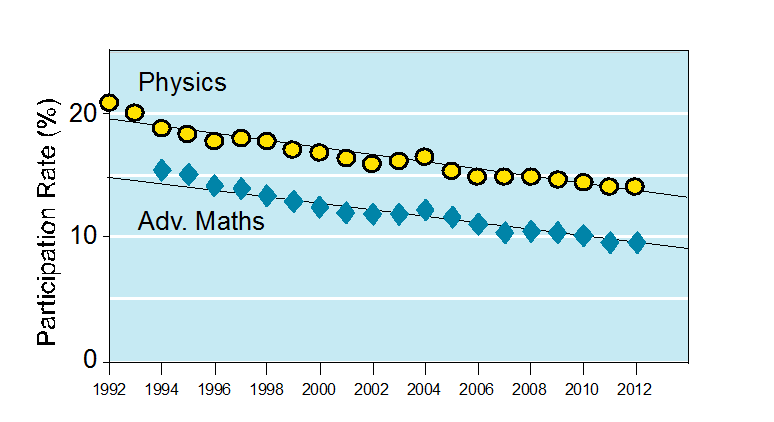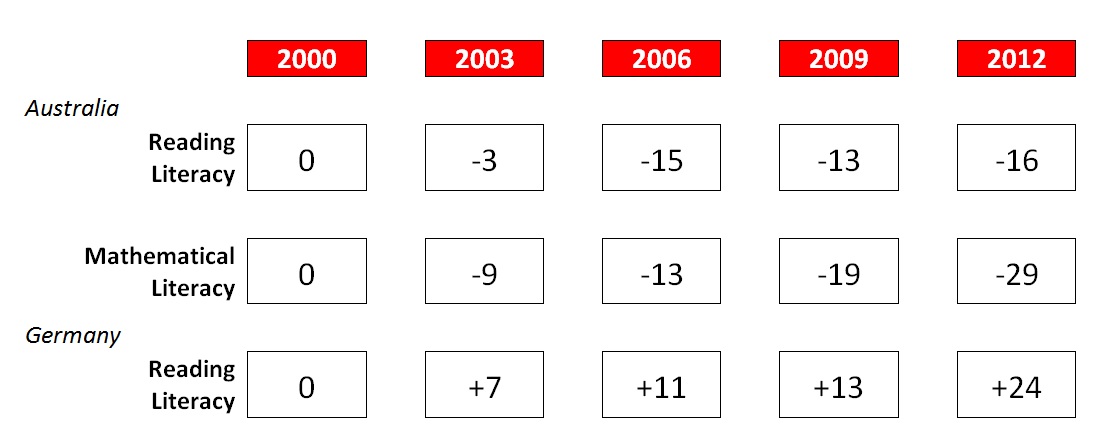A 21st Century curriculum
In my recent Teacher article ‘Big five' challenges in school education I argue that one of the biggest challenges we face in school education is to identify and develop the knowledge, skills and attributes required for life and work in the 21st Century. This is an ongoing curriculum challenge.
There are several reasons for questioning how well the current school curriculum is equipping students for life beyond school.
First, there has been a long-term decline in the ability of Australian 15-year-olds to apply what they are learning to everyday problems. This decline is evident in performances in the OECD's Programme for International Student Assessment (PISA). Over the first twelve years of this century, Australian students completed their compulsory study of mathematics and science with declining levels of ‘literacy' – that is, declining abilities to apply fundamental concepts and principles in real-world contexts.

Figure 1. Average performance of Australian 15 -year -olds in reading, mathematical and scientific literacy (2000-2012)
These declines are occurring at a time when literacy levels in a number of other countries are improving and when Australia requires a more literate citizenry. As a nation we require adults who can engage in a discerning way with sophisticated information about a growing number of complex societal and environmental challenges.
Second, we have witnessed a long-term decline in the proportion of Year 12 students choosing to study advanced subjects – especially advanced mathematics and science subjects. For example, the national participation rates in physics and advanced mathematics have been declining steadily for the past two decades (Figure 2).
Again, these declines are occurring at a time when the economy and an increasing number of occupations are requiring graduates with advanced science, technology, engineering and mathematics (STEM) skills. Long-term trends in participation rates raise questions about the future supply of STEM specialists (including mathematics and science teachers) and about the implications for Australia's ability to compete and contribute to international research and advances in these fields.

Figure 2. National participation rates in Year 12 physics and advanced mathematics (1992-2012)
And there are other reasons for questioning how well the school curriculum is preparing students for life and work in the 21st Century:
- Current curricula often are dominated by substantial bodies of factual and procedural knowledge, at a time when it is increasingly important that students can apply deep understandings of key disciplinary concepts and principles to real-world problems.
- School subjects tend to be taught in isolation from each other, at a time when solutions to societal challenges and the nature of work are becoming increasingly cross-disciplinary.
- School curricula often emphasise passive, reproductive learning and the solution of standard problem types, at a time when there is a growing need to promote creativity and the ability to develop innovative solutions to entirely new problems.
- Assessment processes – especially in the senior secondary school – tend to provide information about subject achievement only, at a time when employers are seeking better information about students' abilities to work in teams, use technology, communicate, solve problems and learn on the job.
- Students – especially in the senior secondary school – often learn in isolation and in competition with each other, at a time when workplaces are increasingly being organised around teamwork and are requiring good interpersonal and communication skills.
School curricula tend to be designed for delivery in traditional classroom settings, at a time when new technologies are transforming how courses are delivered and learning takes place.
Challenges of these kinds will not be addressed by changes to the school curriculum alone. They also depend on investments in teacher quality, changes in pedagogy (how curriculum content is taught) and the alignment of assessment processes to new curriculum priorities. Nevertheless, the content and organisation of the curriculum and the emphases given to different forms of learning in the curriculum are important determinants of student engagement and learning outcomes.
A national key performance indicator (KPI)
Although there is much more to the school curriculum than literacy and numeracy, students' abilities to read and understand different forms of written material and to apply mathematics to everyday problems are among the most important outcomes of an effective curriculum. These are building blocks for many other curriculum areas and essential skills for life and work beyond school. It is for this reason that many countries monitor the literacy levels of 15 -year -olds through the OECD's PISA surveys. For Australia, a curriculum challenge is to develop higher levels of these skills by the completion of secondary schooling.
A simple measure of success in achieving this goal is available through PISA. Figure 3 shows changes in Australia's mean reading and mathematical literacy results since 2000. Reading literacy declined by 16 points and mathematical literacy by 29 points over this 12 -year period [1]. In contrast, the mean reading literacy level in Germany increased by 24 points over the same period. The immediate goal should be to arrest this decline in Australia's performance. The longer-term goal should be to return the performances of Australian students to at least the levels at the turn of the century.

Figure 3. Change in mean student performance since 2000 (OECD PISA)
A second indicator of success would be an increase in the percentage of Year 12 students choosing to study advanced STEM subjects. Despite the important of these disciplines in the 21st Century, including their relevance to a growing number of occupations, a declining percentage of students are attracted to study advanced STEM subjects. A significant reversal in current trends may require a radical rethink of the advanced STEM curriculum.
A third indicator would be a measurable increase in the kinds of general skills and attributes now being sought by employers – for example, students' abilities to work in teams, use technology, communicate, solve problems and learn on the job. Currently we lack valid and reliable measures of ‘new metrics' of these kinds. A challenge is to develop credible indicators of such capabilities and to use these indicators to evaluate curriculum reform efforts.
Some priorities
A curriculum that prepares students for life and work in the 21st Century is likely to be one that includes an emphasis on:
-- deep understandings of subject matter and the ability to apply what is learnt;
-- the ability to communicate and solve problems in teams;
-- the ability to think critically and to create novel solutions; and
-- flexibility, openness to change and a willingness to learn continually.
Here are two specific challenges for a 21st Century curriculum:
- prioritise depth not breadth of learning
The balance between breadth and depth is a fundamental consideration in all curriculum design. Breadth relates to the range or amount of content (often factual and procedural knowledge) covered in the curriculum. Depth relates to the development of deep understandings of key concepts and principles and the ability to apply these understandings in unseen contexts. Ideally, a curriculum would promote both broad and deep learning; in practice, an emphasis on one form of learning often limits opportunities for the other.
For example, school curricula are sometimes described as being ‘crowded' with content that teachers are expected to cover. The attempt to provide students with some knowledge about a wide range of topics can lead to ‘mile wide inch deep' curricula that result in superficial learning, incomplete understandings of core concepts and limited ability to transfer and apply knowledge to unfamiliar contexts.
Although the mastery of factual and procedural knowledge is essential in all school subjects, this knowledge must be more than a list of facts and formulas; it must be organised around core concepts or ‘big ideas' of the discipline [2]. At the present time, the requirement that teachers cover a wide range of curriculum topics often limits the time available to develop deep appreciations of core disciplinary concepts.
-
promote cross-disciplinary, team-based problem solving
An important question at any time is how well the school curriculum is preparing students with the knowledge and skills required for life and work beyond school. In the past, the curriculum prepared students with skills and knowledge for a lifetime of work in specific, well-understood occupations. In the 21st Century, the curriculum must prepare students for working lives that may span a range of occupations, many of which may not currently exist. An increasing number of students are likely to work in cross-disciplinary teams that form and re-form around emerging challenges, often resulting from advances in digital technologies.
To prepare students for life and work of this kind, the school curriculum needs to include a greater focus on the collaborative solution of real, complex problems. For example, in the senior secondary school, rather than teaching, assessing and reporting student learning only in the context of traditional disciplines, students could be required to work in teams on cross-disciplinary challenges. Through these challenges they could be taught how to apply disciplinary knowledge and understandings in new contexts and assisted to develop skills in working as a team, creating innovative solutions, communicating, solving problems and using technology. Students' work on such projects could be assessed and reported alongside their subject results, providing evidence of a broader range of 21st Century skills and attributes.
[1] 16 points and 29 points represent .16 and .29 of the international standard deviation in 2000.
[2] Bransford, JD, Brown, AL & Cocking, RR (1999). How People Learn: Brain, Mind, Experience, and School. Washington: National Academy Press.
